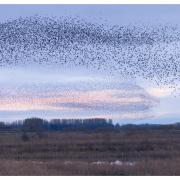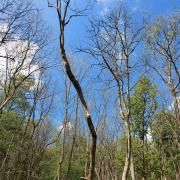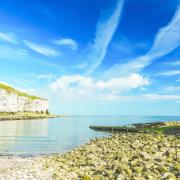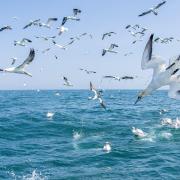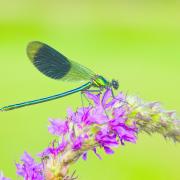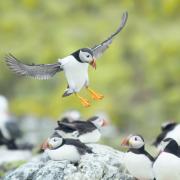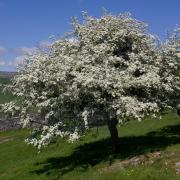Puffins return to Yorkshire in late March and begin to depart during July, with peak viewing in May and June.
RSPB Bempton Cliffs and Seabird Centre, Bempton, YO15 1JF
Renowned all-access and family-friendly viewing areas, video camera technology and a brand new visitor centre.
YWT Flamborough Cliffs, North Landing, YO15 1BJ
Experience puffins the wild way, from open clifftop vantage points at North Landing, Briel Nook and other smaller bays.
The Yorkshire Belle, Bridlington Harbour
A relaxed and stately cruise below the towering clifftops, with friendly onboard commentary so you don't miss a moment of action.
Living Seas Safaris, North Landing, YO15 1BJ
Yorkshire Wildlife Trust guides regularly join the Emmerson family on their short afternoon trips on traditional Yorkshire 'coble' fishing boats.
Puffin Patrols and Peering at Puffins, Bempton and Flamborough
Join expert guides at these two top spots to get your eye on the prize - regular timetables available at Bempton and the Living Seas Centre, South Landing.
It may be an icon of Yorkshire's coastal wildlife, but our favourite seabird has recently made the headlines for the wrong reasons. Yorkshire Wildlife Trust's Tom Marshall investigates
You always remember your first time. It's the black and white feathered belly haughtily thrust beyond the rocks - but it could of course be a razorbill or a guillemot. Then a flash of colour from a pair of feet below catches your eye, they're definitely orange - aren't they? Finally, hue by hue a rainbow bill appears followed by that huge teardrop eye, now there's definitely no mistaking it.
There are few creatures as universally recognisable and guaranteed to raise a smile as the Altantic puffin. With that feathered tuxedo and contrasting vibrant beak, there's no surprise it regularly tops the popularity stakes as one of our favourite birds.
Yorkshire has been for many years and remains today, perhaps the best place to encounter these diminutive seabirds anywhere on mainland Britain. But what is life really like for a puffin?
The truth is, we only really see a small proportion of the puffins' lives when they make the necessary nesting trip to our coast and cliffs, staying for just a few short summer months. While guillemots and razorbills jostle for position on perilous cliff-top accommodation, puffins opt for the peace and tranquillity of an arm's length-deep burrow on offshore islands dotted around the UK coast, or for those at Yorkshire Wildlife Trust's Flamborough Cliffs, a narrow crevice among the chalk.
This choice of des res has some logic behind it. With hungry gulls patrolling above or opportunistic stoats and weasels on the cliffs, a 'puffling' (yes, really) needs to keep a low profile. With their offspring safely tucked away, feeding for puffin parents is a relentless task, but they're well prepared to make the most of every fishing trip. Short, stiff and powerful wings make for a blur of 50mph feathers as they torpedo through the air, but once underwater, the wings become paddles, taking the puffin up to 60 metres feet below the waves in search of their preferred sand eels.
When fellow diners like the gannet or kittiwake have to stop short, the puffin brings its secret weapon into play, with a specially adapted beak capable of carrying more than a dozen sand eels at once. Filled to bursting by a pair of dutiful parents, the young puffins will leave the nest after around a month and a half, and once that first leap of faith into the waves has been made, they're unlikely to set foot on land again for four or five years, then choosing a mate for life.
Although not present in the numbers witnessed on sites like the Farne Islands in Northumberland or Wales' Skomer, Yorkshire's estimated 500 pair-strong puffin colony stretching from Yorkshire Wildlife Trust's Flamborough Cliffs and north to RSPB Bempton Cliffs is equally unique in being the only viewable mainland puffins in England. This special title finds the Flamborough Headland an irresistible draw for almost 200,000 people a year - both a crucial stronghold for the puffin and a foundation to a growing multi-million pound local tourism industry.
Whether from an orchid-laden vantage point at Flamborough, an easy-access viewing area at Bempton or with a seal's eye view aboard a boat below the cliffs, there's no doubt the puffin is one of the county's headline wildlife attractions.
Sadly however, the puffin's presence in large numbers on offshore islands around much of the UK coastline belies a worrying trend for the Atlantic puffin, and one that just a few months ago found our favourite seabird on the unenviable IUCN 'Red List' of endangered species.
The puffin's status in Norway, Iceland and Faroe Islands has conservationists worried, with year-on-year declines in chick numbers coupled with some seasons of complete failure suggesting population 'crashes' could be inevitable without sufficient replacements of youngsters. Similar trends have been recorded as far south as northern Scotland, but thankfully not yet on the Yorkshire coast.
With Europe holding more than 90% of the world's population of Atlantic puffins and a projected decline of 50% by 2065, the need for action is clearly apparent. The challenges for puffins are varied and complex. Climate change is likely to lead to fluctuations in location and availability of their favoured food source - the sand eel - through sea temperature warming, while fishing in some parts of the Atlantic is also directly affecting the availability of sand eels, forcing them to eat less nutritious species such as pipefish. In addition, one-off threats from oil spillages and increases in marine litter have the potential to impact on the birds' everyday behaviour.
With tough times ahead for puffins and other seabirds, Yorkshire has once again been at the forefront of innovative projects in the protection of the marine environment and the wildlife that depends upon it.
Under the banner of 'Living Seas' the Yorkshire Wildlife Trust has been campaigning for Marine Conservation Zones - the 'nature reserves of the sea' - vital pieces in the jigsaw to connect protected areas in our oceans to create a coherent network of sites that will act as a refuge for wildlife and the food upon which they depend. At Bempton, teams have been exploring ground-breaking new ways to survey and monitor seabird numbers - a notoriously challenging task atop 400foot cliffs - piloting drone technology among other ideas.
It's important however, to understand that our seas are also a source of livelihood for coastal communities. The Wildlife Trust's 'Beach Boats' project helps to promote sustainable use of local fisheries with families that have been dependent on the Yorkshire coast for generations, and a ground-breaking 'Fish for Litter' campaign sees local fisherman hauling their nets not only for the catch of the day, but for some of the tonnes of rubbish that finds its way into the waves. Puffins also provide a colourful thrill for passengers on traditional Yorkshire coble pleasure trips from North Landing on summer afternoons, in boats that hours earlier were pulling up a shellfish catch.
This careful and considered management of our vital Heritage Coast means that if we can get things right out at sea too, when the puffins return each April they will still be there for the future - so everyone can enjoy that special first time with our favourite bird.










